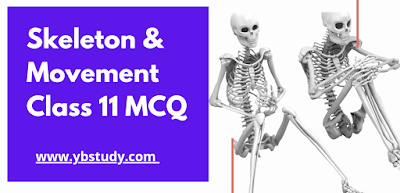Class 11 Biology Chapter 16 Skeleton and Movements MCQ Maharashtra Board
Class 11 Skeleton and Movement MCQ Pdf:
Now it is the time to speed up your study and score well in the Maharashtra board exam by studying Skeleton and Movement MCQ Questions for Class 11 Biology Maharashtra board with Answers PDF. You should practice MCQ for class 11 biology students regularly to strengthen your confidence and improve your skill. Make your accuracy hundred percent by thoroughly revising the Maharashtra board class 11 biology Multiple Choice Questions with Answers on Skeleton and Movement textbook solutions.
By thoroughly practicing these Multiple Choice Questions with Answers you can make your base stronger. Make your board exam preparation stronger. Practice Biology Quiz Questions with Answers for the Class 11 Maharashtra board in your mind and make your preparation effective.
To do well in all such objective-type questions, students should know all the basic concepts of Skeleton and Movement. We have provided here the Skeleton and Movement MCQs for Maharashtra board Class Biology that will help students revise all important concepts and topics in a short time but effectively.
Class 11 Skeleton and Movement MCQ Maharashtra Board :
A. The functional unit of striated muscle is…………..
a. cross bridges
b. myofibril
c. sarcomere
d. z-band
Answer: B
B. A person slips from the staircase and breaks his ankle bone. Which bones are involved?
a. Carpals
b. Tarsal
c. Metacarpals
d. Metatarsals
Answer: B
C. Muscle fatigue is due to accumulation of……..
a. pyruvic acid
b. lactic acid
c. malic acid
d. succinic acid
Answer: B
D. Which one of the following is NOT antagonistic muscle pair?
a. Flexo-extensor
b. Adductor-abductor
c. Levator-depressor
d. Sphinetro-supinator
Answer : D
E. Swelling of the sprained foot is reduced by soaking in hot water containing a large amount of common salt,
a. due to osmosis
b. due to plasmolysis
c. due to electrolysis
d. due to photolysis
Answer: A
F. Role of calcium in muscle contraction is………
a. to break the cross bridges as a cofactor in the hydrolysis of ATP
b. to bind with troponin, changing its shape so that the actin filament is
exposed
c. to transmit the action potential across the neuromuscular junction.
d. to re-establish the polarisation of the plasma membrane following an action potential.
Answer: B
G. Hyper-secretion of parathormone can cause which of the following disorders?
a. Gout
b. Rheumatoid arthritis
c. Osteoporosis
d. Gull’s disease
Answer: C
H. Which joint occurs between the humerus and radioulnar?
(a) Ball and socket joint
(b) Sliding
(c) Pivot
(d) Hinge joint
Answer : D
I. One of the following is true of muscle contraction.
(a) H-zone expands
(b) I-band expands
(c) A-Band remains constant
(d) The sarcomeres expands
Answer: C
J. _______________ is an example of an imperfect joint.
(a) Ball & socket joint
(b) Pubic symphysis
(c) Elbow joint
(d) None of the above
Answer: B
K. The ______ is the largest sesamoid bone in the human body.
(a) Pelvis
(b) Femur
(c) Ulna
(d) Patella
Answer: D
L. The _______ is the only movable part of the skull.
(a) Nasal Conchae
(b) Mandible
(c) Vomer
(d) Maxilla
Answer: B
M. _______ is the muscle’s contractile protein.
(a) Globulin
(b) Elastin
(c) Myosin
(d) None of the above
Answer: C
N. Which one of the following is the correct pairing of a body part and the kind of muscle tissue that moves it?
(a) Iris – Involuntary smooth muscle
(b) Heart wall – Involuntary unstriated muscle
(c) Biceps of the upper arm – Smooth muscle fibers
(d) Abdominal wall – Smooth muscle
Answer: A

